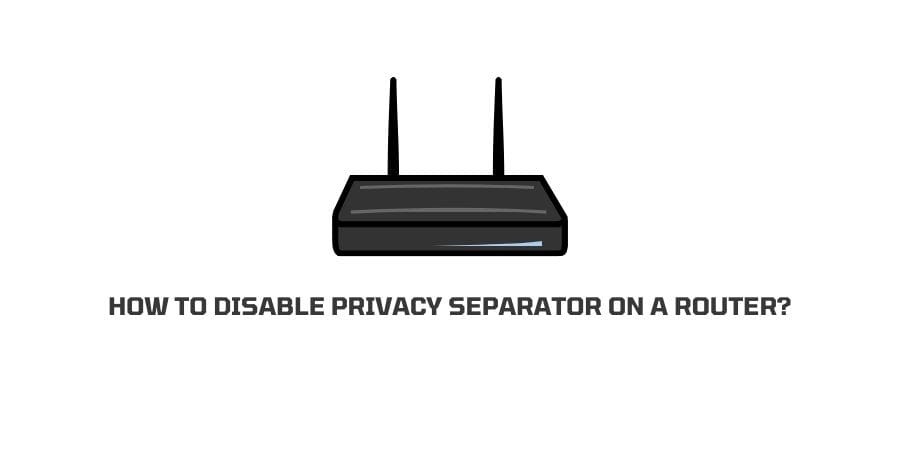
Since you are already here looking for ways on, “How to Disable Privacy Separator on a Router?”. My guess is that you already are more or less well aware of what a Privacy Separator is and what it is meant to do for you.
However, if you have just recently come across this feature on your modem or router. Then chances are you are still a little lost on what it is and why it is actually there in the first place. If so, then the next section should help you answer just that.
But, if you are already aware and know better what a Privacy Separator is and just want to know the Steps needed to Disable Privacy Separator on your Router. Then, you can directly jump to the following section on, “Steps to Disable Privacy Separator on Router”, without wasting time on the “Why” & “What”..
What are Privacy Separators in Routers?
As the name itself might suggest, Privacy Separators in Routers are nothing more than simply a feature or function which allows the user to separate or isolate devices connected to a Wi-Fi network from each other.
Moreover, given that it has the word “privacy” added to the beginning easily means that it is such a feature which deals with the security and privacy of your data and devices connected to your modem or router and vice versa.
There is just no doubt that the modern modem and router models we use today come with their own set of rich functionalities and features, making them absolutely efficient as well as secure.
The above feature too, can be considered such a feature out of the many which help its users to secure their network and keep devices connected to their network safe and secured.
But then, why would you want to Disable such a Privacy Separator feature in your Router.
Given that such a feature is good for your network, as well as the safety and security of the various devices connected to your network. Then why would you need to disable it in the first place?
Well, the answer is quite simple actually.
Let me explain to you with the help of a simple example, just to make things a little simpler and easier for you to understand.
Now, imagine that you are at a restaurant which along with great food also provides free public wi-fi service to its customers. And it is just quite obvious that most people there will connect to the network to use the Internet as they see fit.
Here, although most users connected to the network will use the internet to simply browse content online or work on their projects to meet deadlines. There may be a few however, who might have malicious intent.
In such a situation, if the privacy separator is disabled, then someone with malicious intent can easily attack other devices on the same network and compromise their security.
Due to this reason, having such a feature enabled on your router or modem can greatly help prevent any such misfortunes from happening as well as keep all devices and data on the network safe.
However, there are times when devices might need to communicate to each other over a network to carry out certain operations together. Then again, in such cases having the Privacy Separator feature might do more harm than good.
Suppose, you have a common printer at home or an office used by all the members residing in that house or building. Now, obviously just having one single device connected to that particular printer would not make things easier. Right?
In order to do things more efficiently and smoothly, the best option would be to let the printer as well as all other devices in the buildings communicate with each other over a single network, so that anyone from anywhere in the building or house can print on demand from their respective machines connected to the same network.
And hence, in such a case if the Privacy Separator feature is enabled, separating and isolating all the devices on a network from each other. Then, carrying out such operations as explained above, over a network might not be possible.
How to Disable Privacy Separators in your Router?
In the following section, I’ll try to walk you through the steps involved in disabling and enabling your router’s privacy separators as needed.
Here it is important to note that the steps to disable the feature on your router may differ from brand to brand and even from model to model.
And hence, below I will try to list the steps in a more general way so that it is applicable on any type of network device you are using, irrespective of their brand or model.
- For the very first step, you will need to go to your router’s admin panel. For this, either you will have the option to directly go to your router’s admin panel with the help of a native router app or simply type in the IP address to the admin panel.
- If you are not sure where or how to go to your router’s admin panel, you can simply google it. There will be a separate set of instructions for different brands and models. Or, you can simply call up customer support to ask for your modem or router’s admin panel access.
- So, once you have gained access to the admin panel. Next, head to your router’s advanced settings option and go to the privacy and settings option there.
- Once you are inside the privacy and settings menu, you will need to search for and locate the privacy separator option and click on it.
- Inside the privacy separator option, look out for an option like wireless isolation. If such a choice ispresent select it and then disable the settings.
Once again, it is important to keep in mind that the above mentioned steps may not prove to be an exact representation of the actual steps which might be needed for your particular router or modem model.
Hence, irrespective of how you go on executing the steps to disable your router’s privacy separator option. Your final goal should be to just disable it at the end by locating the option which allows you to do so.
Conclusion
So, in the end it all sums up to what kind of a set-up you have at home as well as what are your needs.
If you have a wi-fi network at your home or office with a known and limited number of devices over the network. Then, having the Privacy Separator on your respective network devices should not be much of a concern anyways.
However, if you have kept the connection public and open to all. Then, keeping the Privacy Separators enabled would prove more beneficial, keeping your network as well as all the devices connected to it safe and immune to any kind of malicious attacks or breach.
Like This Post? Checkout More
